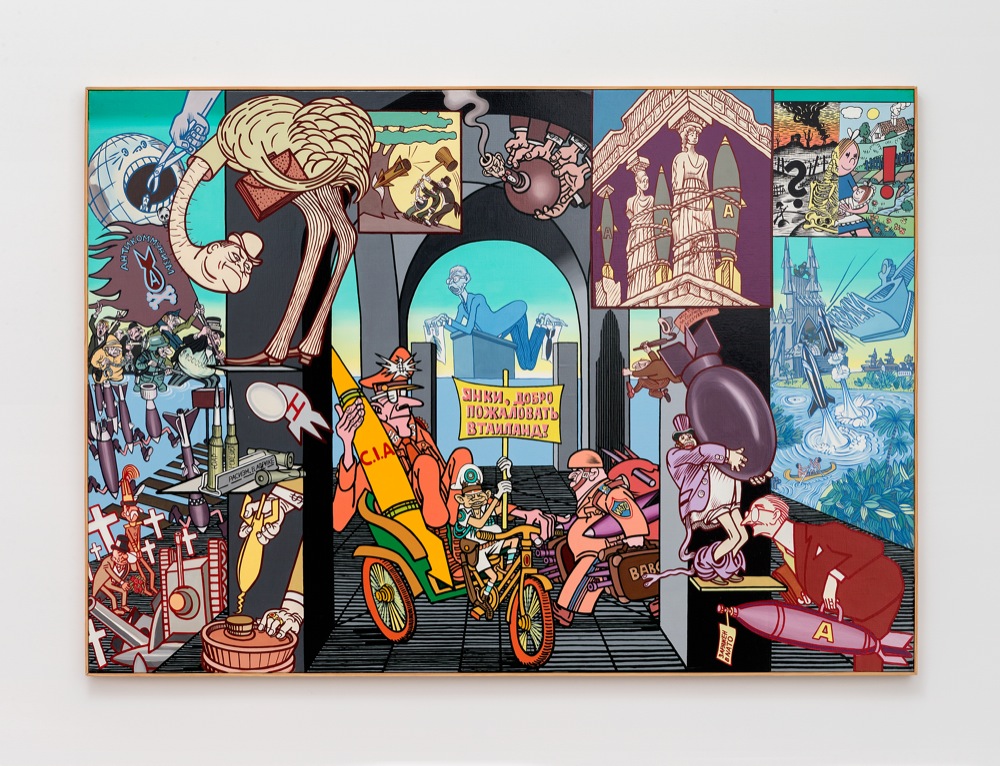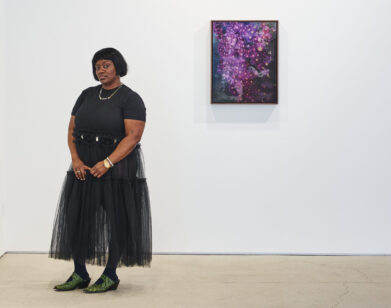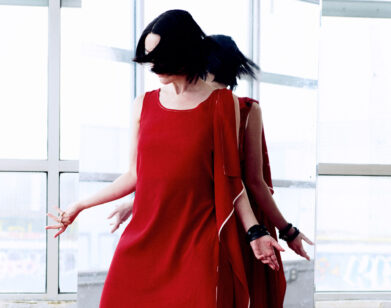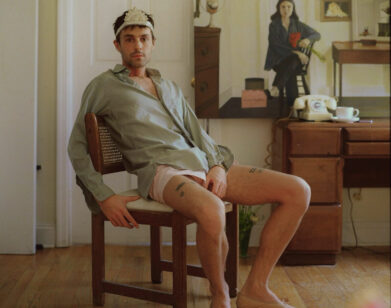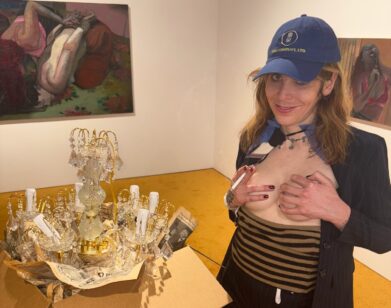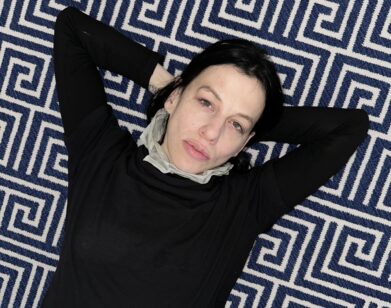Erró’s Pop and Politics
Although the artist Erró formally studied classical painting, fresco, and mosaic in Oslo, Florence, and Ravenna, respectively, his practice more closely reflects those of the surrealists and pop artists. Now known for his painted collages (the act of painting montages originally created from ready-made images), the Iceland-native fuses pop culture with politics, art history with satire, and reality with fiction. His flamboyant canvases have been coined baroque pop, and aptly so, yet the New York movement is far from where Erró began.
Currently on view at Galerie Perrotin in New York, “Erró: Paintings from 1959 to 2016” provides an overview of the artist’s evolving career. Through 15 carefully curated canvases, the exhibition traces Erró from his early days in Paris, when he was surrounded by the likes of Marcel Duchamp, André Breton, and Max Ernst, to his first visit to New York in 1964, when he met Andy Warhol, Roy Lichtenstein, et al., to his current life in Paris, where he continues to make culturally relevant work, depicting everything from Miley Cyrus (Poutine et Miley Cyrus, 2013) to Snoop Dogg with a bulldog and sheep (Dogman, 2013).
“I have been very lucky, I have won prizes and I’ve even won the lottery,” Erró admits. “It helped me to get out of Iceland…Things have been a happy and wonderful life.”
Just after the opening of the exhibit, which marks his first with Galerie Perrotin, Erró met photographer and old friend Martine Barrat at the Chelsea Hotel, where Barrat still lives. Here, the two spoke about everything from shooting Grace Jones in Harlem to being served dinner by Leo Castelli at Robert Rauschenberg’s studio, but they begin with the simple story of how they first met.
ERRÓ: I was in the academy in Oslo, in my second year. Martine, I met you when you were about 15 years old, and all of us just melted. [laughs]
MARTINE BARRAT: I was posing for the class [you were taking]. I was a model for sculpture or painting…
ERRÓ: So we’ve known each other for a very long time, but when you don’t see your very good friend for 20 years, 30 years, and you see them again, the person has changed, you have changed. I was thinking about this when I came to New York a few days ago. I’ve been away for almost 60 years, so the atmosphere and all the friends from the ’60s are gone, the town has changed, and I have changed too. I have very warm memories about New York, about the old times, mostly the ’60s.
BARRAT: That was a great time in New York—full of life, of music, poetry.
ERRÓ: There was a party every two days, all the doors were open, and people were friendly. And we have to say, the prices were so low, it was unbelievable. We rented an enormous loft for $300 a month, which is finished now, life is different. I lived on Fulton Street in an enormous studio—I needed a bicycle to get to the toilet, about half a mile between two streets—next to Wall Street. At the time the fish market was there. Saturday and Sunday, nobody was working on Wall Street so we had the whole quarter to ourselves.
BARRAT: I became a photographer in ’76, [but] I was doing video before and I was a dancer for a long time—that’s how I came to New York. I was in a festival of dance in Edinburgh and one woman saw me and said, “Girl, one day I’m going to send you a ticket so you can do a show in my theater.” She was La Mama, a fantastic black woman who had a theater in the Lower East Side, and two years later I opened an envelope and I got a ticket. So I came to New York in June ’68 and never left. The atmosphere of New York was so creative. People would not talk about money; they would do things. It wouldn’t matter if it made money or don’t make money. Poetry, music, and painting were flourishing in the city. We used to go dancing all the time…
ERRÓ: I have to tell you, I brought my wife over from Thailand and we were looking for a Thai restaurant, and it was next door to the Blue Note. Somebody phoned and said, “It’s the anniversary of Neil Peart, the drummer from Rush, and he’s going to play tonight in the Blue Note.” So we went and all his friends came to play with him, and it ended up being a jam session until 6:00 in the morning.
BARRAT: Things like that all the time, wherever you went. Dancing so much!
ERRÓ: But you never knew who you met, because there was so much going on. I remember a very interesting dinner in the studio of [Robert] Rauschenberg. He had convinced Sidney Janis, Leo Castelli, and a third big gallery man to serve us, the artists, at the table. So they were dressed up as waiters, we were sitting at the table, and they were only allowed to sit down at the end of the table for the cognac. This is not possible now.
BARRAT: No, it’s different. At the time, La Mama gave me a theater on 3rd Street between [Avenues] B and C that still exists, the Nuyorican [Poets] Café. I met a group of musicians with La Mama and we decided to have a workshop of music for children for free. I’d go to Harlem all the time to pick up a bunch of kids and we were having a ball, all the time, creating things… So let’s talk about your exhibition. What was it like choosing just 15 paintings that span five decades?
ERRÓ: I didn’t chose, the gallery chose. They came to me a few weeks before and said they were missing paintings, so I took them to my warehouse outside of Paris where they used to make the cheapest wine in France, sold in plastic bottles. It went broke, so somebody opened a storehouse. There, they selected the paintings that are downstairs, in the last room of the exhibition. There was a big choice [to be made] because I’ve probably made close to 16,000 paintings, and the base of every painting is a collage. I have very good scissors, very good glue, and thousands of documents in drawers—about 80 drawers with different subjects. I could put all this on computers, it would go much faster, but I like to do it by hand.
BARRAT: It blows my mind.
ERRÓ: The great American art critic, Arthur Danto, I took him to the studio and he said, “This is baroque pop.” I’d love to be considered a post-pop artist, but I love to have five or six different styles in every painting, just for the pleasure of the eye. I work on a political subject quite often, and the paintings, for me, are not finished until they’re printed. So every five, six, seven, eight, 10 years I do a raisonné. When it’s printed in the book, it’s finished. [Some people] put their work on the internet and check every day how many people look, how many people made contact, but I don’t have internet, I don’t have a hand-phone, I don’t have fax, I don’t have email. I just have old-fashioned telephone and letters.
BARRAT: Do you remember your first collage?
ERRÓ: The collages I never wanted to sell. I thought it was a very private thing, so I kept the collages. Then, in the end, I had a big collage in the Pinault Collection in Venice and the director of the [Centre] Pompidou said, “Did you make big collages like this in the ’60s?” I said yes, so he came to the studio and said, “Let’s make an exhibition in the Pompidou.” We put up an exhibition of 50 collages and we don’t know what happened, but we got in 300,000 people every day. We didn’t make any special publicity. Nothing.
Then I had an interesting story, a copyright story. There was a stand in front of the Chelsea hotel that sold magazines. All the pop artists came there to find materials. I found in a newspaper with a child on the breast of the mother, I put a gun behind, and I called it Pistol Lait, “pistol milk.” I painted the painting in the hotel and I get a letter from a small town in America, “My daughter went to Madagascar, she came back, on the way she stopped and saw an exhibition. She saw a photo of her on the breast of her mother, a few months old, with a gun behind.” Enormous drama… The whole family crying… I got a few letters, worse and worse. Then the director wrote a letter to him, “It’s been taken out of the exhibition, it should’ve never been exhibited without your permission.” You can have a lot of problems with copyright. Even you photographing people, if you make the most beautiful photograph, they can sue you, eh? [laughs] You’ve photographed Tina Turner, Bob Marley, Run DMC…
BARRAT: I was sent to take a picture of Tina Turner by Yohji Yamamoto, and I met [Run DMC] in the park one day. I was walking in Harlem and here they were—we had a good time, just by accident. With Grace Jones, Azzedine Alaïa told me, “Do what you want, take some pictures.” I took her to Harlem and suddenly there were thousands of people trying to see through the window of the place I took her. It was an old bar called the Harlem Moon and people were standing on each other just to see Grace Jones while I was taking the picture. She was having a good time, showing her legs. [It’s on] my Instagram, now. I’m not like you; I love my Instagram.
ERRÓ: I remember Harlem because the last wife of Picasso, Jacqueline [Roque], wanted to go to Harlem. I said, “I know an interesting place called Small Paradise. Marcello Mastroianni is also in town, he would like to go to Harlem, so let’s go together.” The owner of the place went up on stage and said, “We have this famous Italian actor, Marcello Mastroianni!” Nobody understood. Then he said, “From the film 8 ½‘!” and then, everybody clapping! They brought out a beautiful girl and asked him to dance. He said, “I only know the tango because I learned to dance tango for a film,” so the orchestra started and he danced wonderful tango from one corner to another corner. James Baldwin was also with us.
BARRAT: Baldwin was a fantastic person. I used to give him my cassettes because he said it was very inspiring to him to listen to the children I worked with in Harlem, and then he wanted to meet them… One last question, Erró: Your works lend themselves to pointing out the absurdities of reality, and that reality can, in fact, be much stranger than fiction. At what point in your life did you start to question mass media, politics, and popular culture?
ERRÓ: It all started, let’s call it “kicked in the ass,” when I came to New York. I saw a supermarket, we didn’t have supermarkets in Europe, and I found new friends, new material, and the whole pop group. Jim Dine, Rauschenberg, all these people, and my favorite artist of them all is James Rosenquist. I remember when he got married the second time, he said, “I came to the house with her, I opened the door, I picked her up, and I said, ‘Now I’m going to take you to a place you’ve never been.'” She started dreaming of taking the Concorde to Europe and he brought her to the kitchen. He said, “She doesn’t even know how to cook an egg. But she’s very good on the telephone to reserve restaurants.” [laughs] Wonderful artist. Also, I’m very proud that quite often my paintings are used as illustration in schoolbooks. I like that much more than art books. Things are forgotten so fast today. Even if 1,000 people are slaughtered, the next day you forget. There has to be new news every day. In the exhibition at Galerie Perrotin, they have the Sarajevo painting—I think it’s very good to nail down this story of Pol Pot and other people, not all dictators but most of them.
“ERRÓ: PAINTINGS FROM 1959 TO 2016” WILL BE ON VIEW AT GALERIE PERROTIN THROUGH APRIL 23, 2016.

